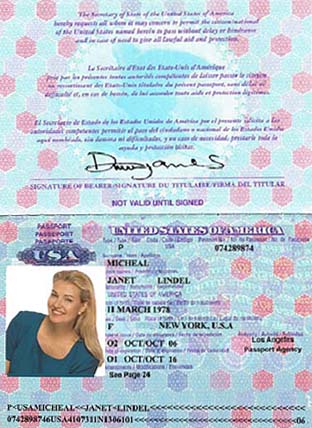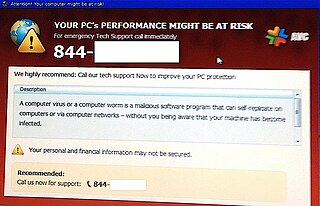Scam baiting is a form of internet vigilantism primarily used towards advance-fee fraud, IRS impersonation scams, technical support scams, pension scams, and consumer financial fraud.

The SAM Lock Tool, better known as Syskey, is a discontinued component of Windows NT that encrypts the Security Account Manager (SAM) database using a 128-bit RC4 encryption key.
419eater.com is a scam baiting website which focuses on advance-fee fraud. The name 419 comes from "419 fraud", another name for advance fee fraud, and itself derived from the relevant section of the Nigerian criminal code. The website founder, Michael Berry, goes by the alias Shiver Metimbers. As of 2013, the 419 Eater forum had over 55,000 registered accounts. According to one member, "Every minute the scammer I'm communicating with is spending on me is a minute he is not scamming a real potential victim."

Scareware is a form of malware which uses social engineering to cause shock, anxiety, or the perception of a threat in order to manipulate users into buying unwanted software. Scareware is part of a class of malicious software that includes rogue security software, ransomware and other scam software that tricks users into believing their computer is infected with a virus, then suggests that they download and pay for fake antivirus software to remove it. Usually the virus is fictional and the software is non-functional or malware itself. According to the Anti-Phishing Working Group, the number of scareware packages in circulation rose from 2,850 to 9,287 in the second half of 2008. In the first half of 2009, the APWG identified a 585% increase in scareware programs.
Ransomware is a type of cryptovirological malware that permanently blocks access to the victim's personal data unless a ransom is paid. While some simple ransomware may lock the system without damaging any files, more advanced malware uses a technique called cryptoviral extortion. It encrypts the victim's files, making them inaccessible, and demands a ransom payment to decrypt them. In a properly implemented cryptoviral extortion attack, recovering the files without the decryption key is an intractable problem, and difficult-to-trace digital currencies such as paysafecard or Bitcoin and other cryptocurrencies are used for the ransoms, making tracing and prosecuting the perpetrators difficult.

Event Viewer is a component of Microsoft's Windows NT operating system that lets administrators and users view the event logs, typically file extensions .evt and .evtx, on a local or remote machine. Applications and operating-system components can use this centralized log service to report events that have taken place, such as a failure to start a component or to complete an action. In Windows Vista, Microsoft overhauled the event system.

A romance scam is a confidence trick involving feigning romantic intentions towards a victim, gaining the victim's affection, and then using that goodwill to get the victim to send money to the scammer under false pretenses or to commit fraud against the victim. Fraudulent acts may involve access to the victim's money, bank accounts, credit cards, passports, e-mail accounts, or national identification numbers; or forcing the victims to commit financial fraud on their behalf.

A computer virus hoax is a message warning the recipients of a non-existent computer virus threat. The message is usually a chain e-mail that tells the recipients to forward it to everyone they know, but it can also be in the form of a pop-up window.
Voice phishing, or vishing, is the use of telephony to conduct phishing attacks.
The Client/Server Runtime Subsystem, or csrss.exe, is a component of the Windows NT family of operating systems that provides the user mode side of the Win32 subsystem. In modern versions of Windows, it is primarily involved with process and thread management, console window handling, side-by-side assembly loading and the shutdown process. Historically, it had also been responsible for window management and graphics rendering, however, these operations have been moved to kernel mode starting with Windows NT 4.0 to improve performance.
Telemarketing fraud is fraudulent selling conducted over the telephone. The term is also used for telephone fraud not involving selling.
In computing, the term remote desktop refers to a software- or operating system feature that allows a personal computer's desktop environment to be run remotely from one system, while being displayed on a separate client device. Remote desktop applications have varying features. Some allow attaching to an existing user's session and "remote controlling", either displaying the remote control session or blanking the screen. Taking over a desktop remotely is a form of remote administration.
Koobface is a network worm that attacks Microsoft Windows, Mac OS X, and Linux platforms. This worm originally targeted users of networking websites like Facebook, Skype, Yahoo Messenger, and email websites such as GMail, Yahoo Mail, and AOL Mail. It also targets other networking websites, such as MySpace, Twitter, and it can infect other devices on the same local network. Technical support scammers also fraudulently claim to their intended victims that they have a Koobface infection on their computer by using fake popups and using built-in Windows programs.

Malwarebytes Inc. is an American Internet security company that specializes in protecting home computers, smartphones, and companies from malware and other threats. It has offices in Santa Clara, California; Clearwater, Florida; Tallinn, Estonia; Bastia Umbra, Italy; and Cork, Ireland.
Tiny Banker Trojan, also called Tinba, is a malware program that targets financial institution websites. It is a modified form of an older form of viruses known as Banker Trojans, yet it is much smaller in size and more powerful. It works by establishing man-in-the-browser attacks and network sniffing. Since its discovery, it has been found to have infected more than two dozen major banking institutions in the United States, including TD Bank, Chase, HSBC, Wells Fargo, PNC, and Bank of America. It is designed to steal users' sensitive data, such as account login information and banking codes.
AnyDesk is a remote desktop application distributed by AnyDesk Software GmbH. The proprietary software program provides platform-independent remote access to personal computers and other devices running the host application. It offers remote control, file transfer, and VPN functionality. AnyDesk is often used in technical support scams and other remote access scams.

Kitboga is the Internet alias of an American Twitch streamer and YouTuber whose content primarily focuses on scam baiting against phone fraud. His channel has over 1 million followers on Twitch, and his YouTube channel has over 3 million subscribers.

Jim Browning is the Internet alias of a software engineer and YouTuber from Northern Ireland whose content focuses on scam baiting and investigating call centres engaging in fraudulent activities.
An SSA impersonation scam, or SSA scam, is a class of telecommunications fraud and scam which targets citizens of the United States by impersonating personnel of the Social Security Administration. SSA scams are typically initiated by pre-recorded messages, or robocalls, which are designed to panic the victim so that they follow the scammer's instructions. In 2018, over 35,000 incidences of SSA scam robocalls were reported to the Better Business Bureau, and the total losses of victims added up to over $10 million. It is believed that approximately 47% of Americans were subject to an SSA impersonation scam robocall during a three-month period in mid- to late 2020, and that 21% of seniors were targeted by at least three SSA scam robocalls in the same time period.
An overpayment scam, also known as a refund scam, is a type of confidence trick designed to prey upon victims' good faith. In the most basic form, an overpayment scam consists of a scammer claiming, falsely, to have sent a victim an excess amount of money. The scammer then attempts to convince the victim to return the difference between the sent amount and the intended amount. This scam can take a number of forms, including check overpayment scams and online refund scams.









